The 16 Mark "How Far Do You Agree with Interpretation 2" Question (Edexcel GCSE History): Revision Note
Exam code: 1HI0
Summary of Question 3 (d)
Question 3 (d) requires you to:
Evaluate the topic outlined in the question
Use both Interpretation 1 and Interpretation 2
This will help you to have a balanced argument
Come to an overall judgement on how far you agree with the topic outlined in the question
You should use Sources B and C in your answer:
They count as your own knowledge
The interpretations used in Questions 3 (b) and 3 (c) will be the same ones used in this question
Like the 16 mark question in Paper 1, you are awarded four marks for Spelling, Punctuation and Grammar (SPaG)
Amount of marks | 16 marks + 4 SPaG marks |
|---|---|
The time that you should spend on the question | 5 minutes of planning 20 minutes of writing |
Below is an example of the type of question you may encounter:
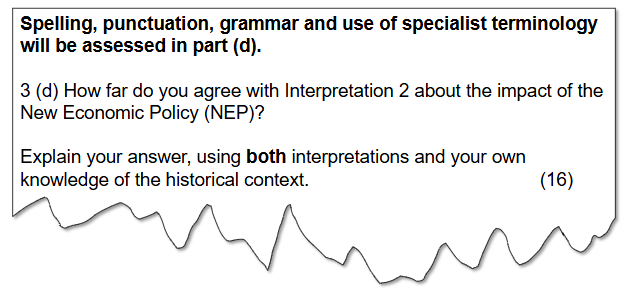
In previous years, this question has focused on the following topics in Russia and the Soviet Union:
Year of Exam
Question Topic
2018
Problems faced by the Provisional Government (opens in a new tab)
2019
The achievements of the Five-Year Plans (opens in a new tab)
2020
Conditions for workers in towns, 1928–41 (opens in a new tab)
2021
Challenges facing the Bolsheviks, 1921–24 (opens in a new tab)
2022
Reasons why Stalin won the struggle for power against his rivals (opens in a new tab)
2023
The main reason why Stalin’s purges began (opens in a new tab)
2024
The experience of women in the Soviet Union under Stalin’s rule
Making judgements in history
The 16 mark question requires you to weigh all the evidence and make a decision
Students often find this part the hardest to do
Common mistakes in judgement questions
Explaining that all of the reasons are the most important
Avoiding a clear decision by using phrases like “kind of” or “maybe”
Giving no opinion
Changing your argument halfway through:
In the example question, you state in the introduction that you fully agree with Interpretation 2
However, in the conclusion, you state that you partially agree with Interpretation 2
Doing this means that there is not a sustained judgement and you cannot access Level 4 (13–16 marks)
What makes a good judgement?
Explain how convincing you find Interpretation 2
Consider the other interpretation
Even if you fully agree with Interpretation 2, you must also evaluate Interpretation 1
Have a consistent judgement from start to finish
Use your best evidence to back up your decision
There is no "right" or "wrong" answer in history
What makes a great conclusion in GCSE History?
Conclusions are usually where most of your judgement marks will be awarded
All great conclusions have these three elements:
Judgement — State how far you agree with Interpretation 2
Counter — Introduce an argument against your judgement
Support — Use your strongest evidence to explain why you have reached your judgement on Interpretation 2
How to get SPaG marks
In Paper 3, students have access to an additional four marks for answering Question 3 (d)
This is awarded for SPaG (Spelling, Punctuation and Grammar)
SPaG Mark | Reason for This Mark |
|---|---|
0 |
|
1 |
|
2–3 |
|
4 |
|
Top tips for boosting SPaG marks
Spell historical terms correctly
Use paragraphs
Re-read your work for punctuation
Reading the answer in your head
Where you would take a breath, make sure there is a comma or full stop
How to answer a "How far do you agree with Interpretation 2?" question
This question asks you how far you agree with Interpretation 2 on a specific topic:
It will be the same topic and interpretations you used in 3 (b) and 3 (c)
In the example question, this topic is "The impact of the New Economic Policy (NEP)"
To answer this question successfully, you should:
Read the answer carefully and multiple times (if you have the time)
Annotate:
The question to know the topic
The interpretations, to come to a judgement
The sources, to select what information you can use to help support your judgement
Plan your answer, including:
What parts of the interpretations and sources you wish to use
An outline of your opinion about Interpretation 2
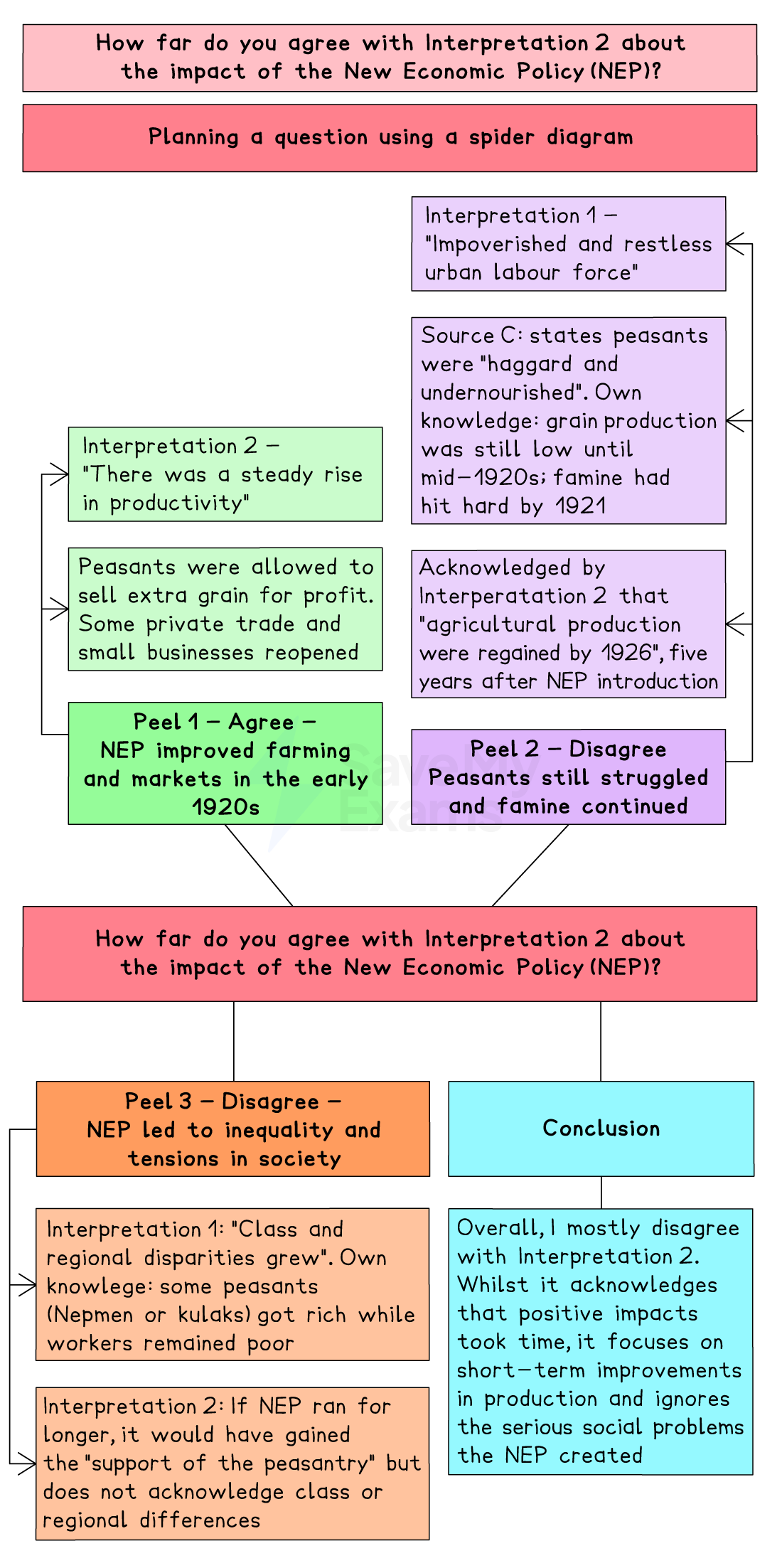
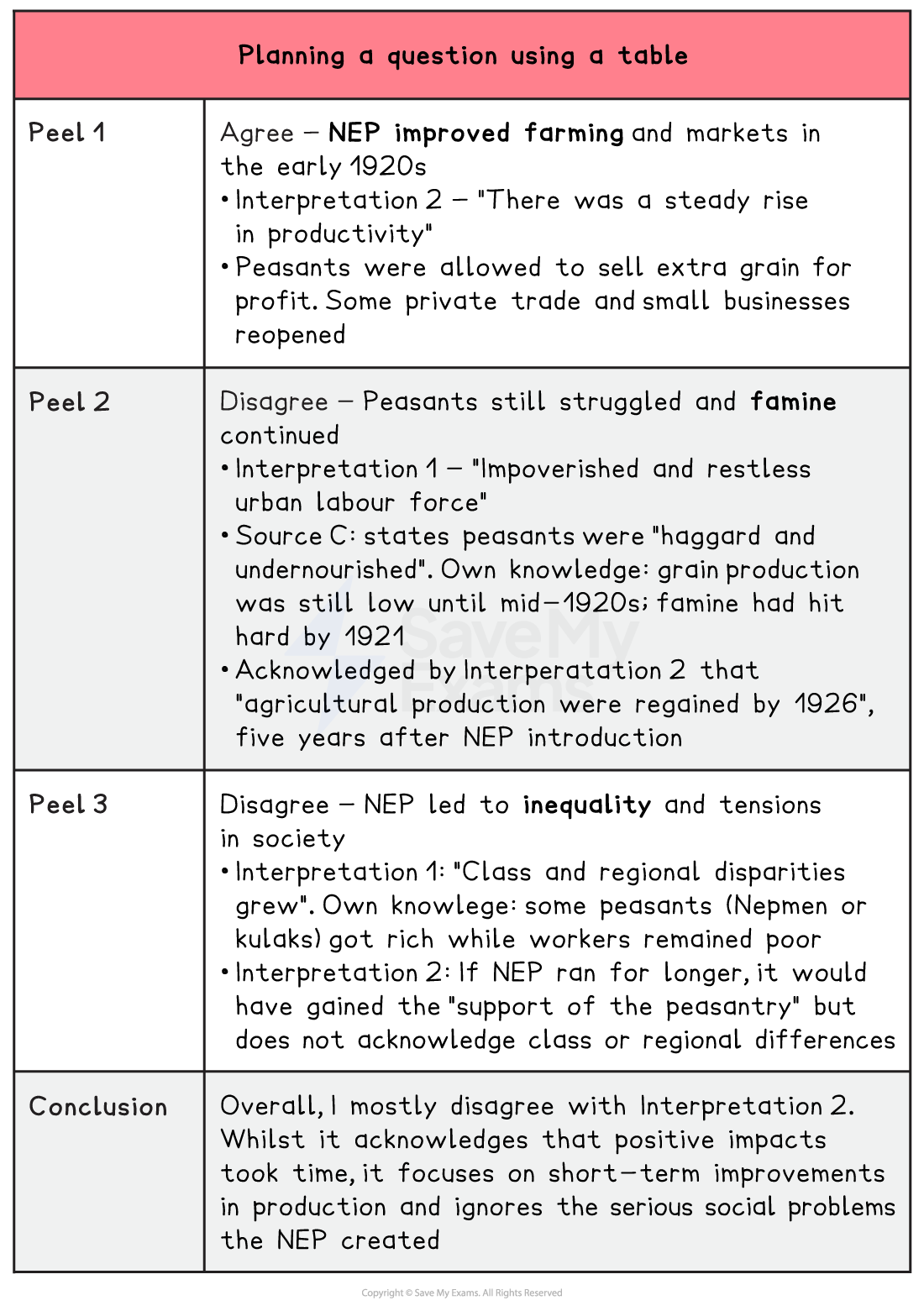
"How far do you agree with Interpretation 2?" question structure
Your answer should include:
A logical structure
Both Interpretation 1 and Interpretation 2
The use of Source B and Source C
Do not use Source A, as you will not be rewarded any marks for your comments
An explanation based on the demands of the question
A clear and sustained judgement throughout the answer
A conclusion
If you want to include an introduction, you can, but it is not necessary
Your answers could be written in PEEL paragraphs:
P — Make a point about the question
This should include your judgement on Interpretation 2
E — Use evidence that supports the point that you have made
Evidence can come from Source B and Source C, or your own knowledge
E — Explain why this evidence supports your point
Your explanation should focus on how much you agree with Interpretation 2
L — Link your explanation back to the question to help sustain your argument and show your understanding of the question
The question is out of 20 marks:
16 marks are awarded for the analysis and evaluation of the interpretations (In)
4 marks are awarded for Spelling, Punctuation and Grammar (SPaG)
This is an overall mark, not awarded in specific areas of your answer
Worked example of a "How far do you agree with Interpretation 2?" question
Worked Example
3 (d) How far do you agree with Interpretation 2 about the impact of the New Economic Policy (NEP)?
Explain your answer, using both interpretations and your own knowledge of the historical context.
(16)
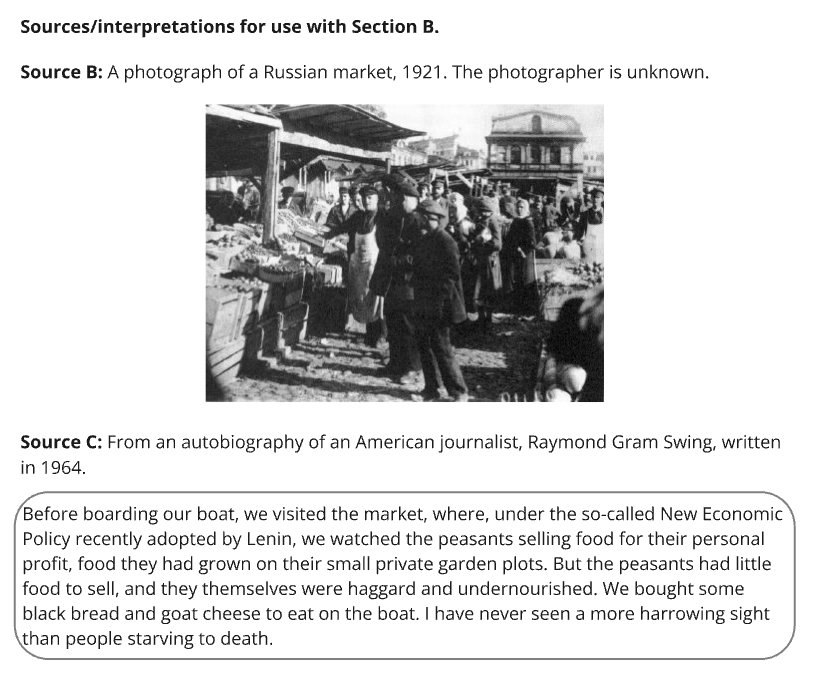
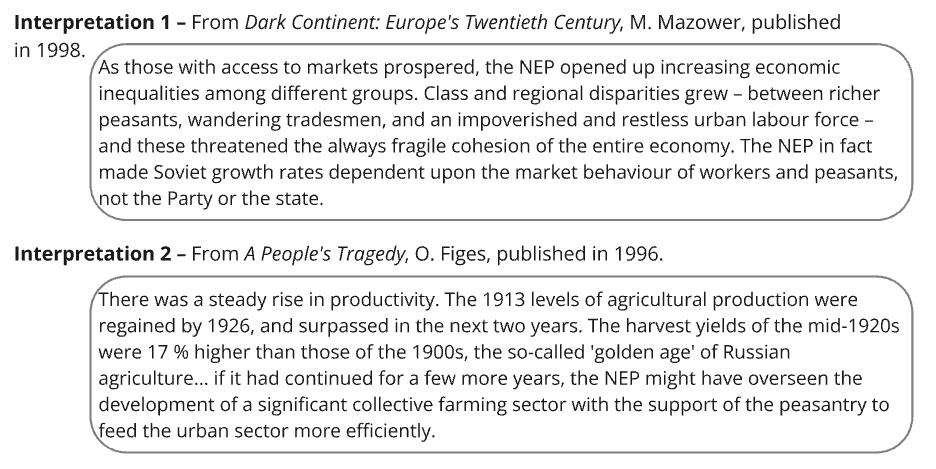
Answer:
I mostly disagree with Interpretation 2 about the impact of the NEP. Although it highlights some improvements to farming and trade, it ignores the wider social problems and tensions that the NEP created (In).
Interpretation 2 argues that the NEP helped increase agricultural production. Figes claims that “there was a steady rise in productivity” and that harvests improved compared to earlier periods. This is partly supported by my own knowledge. Lenin introduced the NEP in 1921 to recover from the failures of War Communism. Peasants were allowed to sell any surplus grain for profit, which encouraged some to grow more food. Small businesses and private trade reopened, and this helped revive local markets and farming communities in the short term (In). This supports Interpretation 2’s view that the NEP did improve production and markets in the early 1920s. Therefore, it is correct to acknowledge the positive economic impacts that the NEP had on Russia (In).
However, Interpretation 2 is too optimistic and ignores serious ongoing struggles. Interpretation 1 describes an “impoverished and restless urban labour force”, which shows that not everyone benefited from the NEP. Source C supports this by describing peasants as “haggard and undernourished” with “little food to sell” (In). I know that food shortages were especially severe in Ukraine. Even with the introduction of the NEP, recovery was slow, and many peasants remained undernourished. Even Interpretation 2 admits that agricultural production was only “regained by 1926”, showing that these improvements took five years. Therefore, although some progress was made, many peasants remained in poverty and faced hardship, which weakens the claim that the NEP had a major positive impact (In).
I also disagree with Interpretation 2 because it overlooks how the NEP increased inequality and tensions in Soviet society. Interpretation 1 argues that “class and regional disparities grew” (In). Some peasants, known as kulaks, became wealthier, while others remained poor. Traders and Nepmen also made private profits, which caused resentment among workers and loyal Communists. These divisions created tensions within the new Soviet system. Interpretation 2 claims that if the NEP had lasted longer, it would have gained the “support of the peasantry”, but it does not recognise the conflicts and inequality the policy created (In). This makes its view less convincing overall.
In conclusion, I mostly disagree with Interpretation 2. Whilst I agree that the NEP improved agricultural production and helped recovery after War Communism, it focuses too much on these short-term improvements and ignores the bigger social problems (In). Interpretation 1 gives a more balanced view of the social divisions and inequalities that the NEP caused. The NEP may have helped some groups, but it did not create lasting stability. This explains why it was abandoned in 1928 (In).

Unlock more, it's free!
Did this page help you?